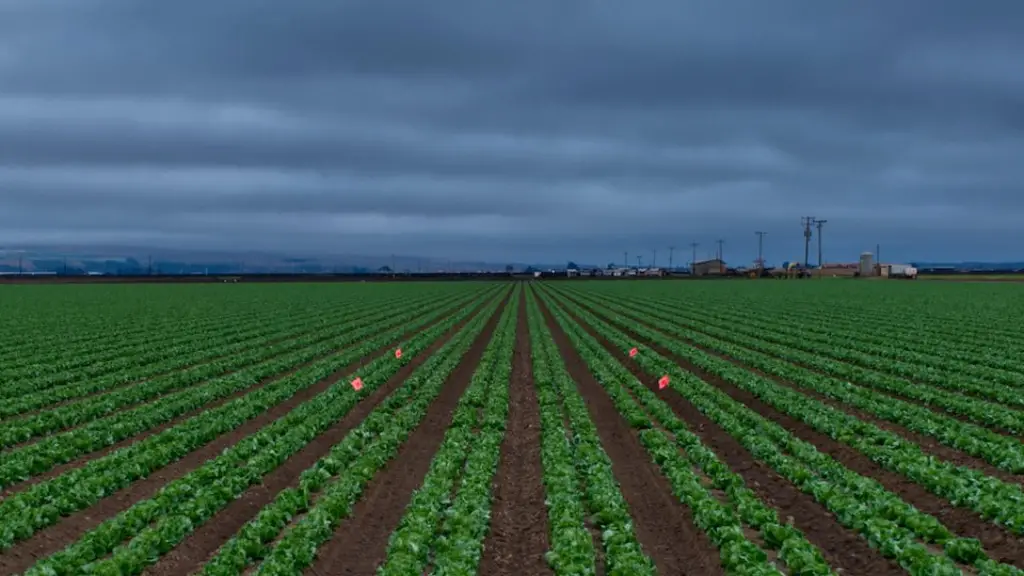Supply chain management is the process of organizing the flow of resources, information and finances as they move in a complex system from farm gate to end user. Agricultural supply chains are often long and complicated, involving many different stakeholders such as farmers, food processors, retailers, and consumers.
Supply chain management in agriculture is the process of coordinating the various activities that need to take place in order to get agricultural products from the farm to the end user. This includes coordination between farmers, processors, packagers, distributors, and retailers.
What is supply chain management in simple words?
SCM is the process of managing the entire supply chain from start to finish. This includes the procurement of raw materials, manufacturing, and distribution of the finished product. The goal of SCM is to optimize the flow of goods and resources in order to achieve the best possible outcome for the company.
Supply chain management is a process that includes the coordination of all activities necessary to produce and deliver goods and services to a business’s customers. This can include activities such as designing, farming, manufacturing, packaging, or transporting.
What does supply chain management do
The supply chain manager is responsible for the coordination, organization, and management of all logistics involved in the production and distribution process of a company’s goods. This includes overseeing the entire life cycle of a product, from the initial stages of procurement and production, to the final stages of distribution and delivery. The supply chain manager must ensure that all elements of the supply chain are running smoothly and efficiently in order to avoid delays or disruptions in the production and/or distribution process.
Supply management is the process of overseeing and coordinating the supply of goods and materials within an organization. It is responsible for ensuring that the correct goods and materials are delivered to the correct location at the correct time, and in the correct quantity.
Supply management is made up of five areas: supply planning, production planning, inventory planning, capacity planning, and distribution planning.
Supply planning determines how best to fulfill the requirements created from the demand plan. Production planning coordinates the production of goods and materials to meet the demand plan. Inventory planning manages the level of inventory to ensure that customer demand can be met while minimizing the cost of inventory. Capacity planning ensures that the necessary resources are available to meet the demand plan. Distribution planning coordinates the distribution of goods and materials to the customer.
Supply management is a critical function within an organization, as it ensures that the correct goods and materials are delivered to the correct location at the correct time, and in the correct quantity.
What are the 3 key points of supply chain management?
The key aspects of Supply Chain management are Purchasing (sourcing), Planning (scheduling) and Logistics (delivery). Sometimes logistics is separate, and procurement may be included with Purchasing, depending upon how location specific the procurement activities are.
Strategic supply chain management is the highest level of supply chain management, and focuses on long-term decisions. Tactical supply chain management is the middle level of supply chain management, and focuses on medium-term decisions. Operational supply chain management is the lowest level of supply chain management, and focuses on short-term decisions.
What are the 2 main goals of supply chain management?
Faster delivery: Supply chain management should focus on reducing the time it takes to get goods to market. This can be done by streamlining operations and improving communication and coordination between suppliers, manufacturers, and retailers.
Higher efficiency: Supply chain management should strive to eliminate waste and unnecessary effort throughout the supply chain. This includes reducing excess inventory, reducing lead times, and improving forecasting accuracy.
Accelerated cash flow: Supply chain management should aim to improve the flow of money throughout the supply chain. This can be done by speeding up payments to suppliers, improving inventory management, and reducing the overall cost of goods sold.
The supply chain is the process that takes raw materials and moves them through the production process until they are ready to be sold to consumers. The four elements of the supply chain are integration, operations, purchasing, and distribution.
Integration is the process of bringing all the different parts of the supply chain together so that they work together seamlessly. Operations is the management of the day-to-day activities of the supply chain. Purchasing is the process of acquiring the raw materials that are needed to create the products that will be sold. Distribution is the process of getting the products from the factories to the consumers.
The goal of the supply chain is to establish a path to competition that is both cost-effective and competitive. To achieve this goal, all four elements of the supply chain must work together efficiently and effectively.
What are the 5 types of supply chain
The six types of supply chain models are:
1. Continuous Flow
2. Fast Chain
3. Efficient Chain
4. Agile
5. Custom-configured
6. Flexible
In order to create and maintain a successful supply chain, there are several key components that must be taken into consideration and managed effectively. These components include:
1. Integration: Integration starts at your strategic planning phase and is critical throughout your communications and information sharing and data analysis and storage. All members of your supply chain must be aligned and working together towards common goals in order for the supply chain to function smoothly.
2. Operations: Operations include all of the activities and processes involved in physically producing and distributing your product or service. From raw materials procurement and manufacturing to order fulfillment and delivery, efficient operations are essential to supply chain success.
3. Purchasing: Purchasing refers to the procurement of the raw materials and components needed to produce your product or service. An effective purchasing strategy will ensure that you are able to obtain the necessary materials and components at the right price and quality while minimizing supplier risk.
4. Distribution: Distribution encompasses the storage and shipping of your finished product or service to your customers. An efficient distribution system is critical to ensuring that your product or service arrives at the customer on time and in good condition.
5. These are the five main components of a supply chain. In order to be successful, it is important to
Which field is best in supply chain management?
There are many supply chain management jobs in India that pay well. Some of the best-paid jobs in SCM include product development, purchasing of materials, inventory control, manufacturing, transportation, and delivery. There is a high demand for SCM jobs in India, and they also pay handsome salaries in India.
1. Quality customer service: The supply chain management is centralized on the needs of the customers. This means that ensuring quality customer service is a top priority. To do this, you need to have qualified personnel who are able to handle customer service issues effectively.
2. Costing: Risk management is an important aspect of supply chain management. This is because you need to be able to control costs in order to be profitable. There are a number of ways to do this, but it requires careful planning and execution.
3. Supplier relationship: A strong relationship with your suppliers is essential for supply chain management. This is because they are the ones who provide you with the materials and products you need. Without a good relationship, it can be difficult to get the supplies you need in a timely manner.
4. Qualified personnel: As mentioned above, qualified personnel are essential for supply chain management. They need to be able to handle customer service issues and be able to cost effectively manage the supply chain.
5. Unforeseen delays: There are many potential delays that can occur in the supply chain. This includes supplier delays, transportation delays, and even customer delays. It is important to have contingency plans in place to deal with these delays.
What are the 7 R’s of supply chain management
The 7 Rs are important considerations when managing logistics and transport. Getting the right product, in the right quantity, in the right condition, to the right place, at the right time, to the right customer, at the right price, is crucial to ensuring efficient and effective operations.
The seven strategies in the McKinsey 7S model are organization structure, management strategy, systems, styles, skill, staff, and shared values. Each of these strategies is interrelated and must be aligned in order for an organization to be successful.
Organization structure refers to the way in which an organization is structured. This includes the hierarchy of authority, the way decisions are made, and the way work is divided among different departments.
Management strategy refers to the overall strategy that an organization uses to achieve its goals. This includes the specific plans and actions that managers take to promote growth and profitability.
Systems refer to the various processes and procedures that an organization uses to operate. This includes financial systems, information systems, and production systems.
Styles refer to the culture and values that an organization possesses. This includes the way employees dress, the way they interact with customers, and the overall atmosphere of the workplace.
Skill refers to the ability of an organization to execute its plans and achieve its objectives. This includes the ability of employees to perform their jobs, the ability of managers to lead and motivate employees, and the ability of the organization to adapt to changes in the marketplace.
Staff refers to the people who work for an
What is another name for supply chain?
The terms supply chain management (SCM) and business logistics management—or simply, logistics—are often used interchangeably. However, there is a subtle yet important distinction between the two: SCM encompasses the entire process of acquiring raw materials and transforming them into finished products, while logistics refers specifically to the transportation and storage of those finished products.
In other words, logistics is a subset of SCM. And because transportation and storage play such a critical role in the overall supply chain, logistics management is often a key determinant of a company’s overall competitiveness.
Logistics management is the process of planning, implementing, and controlling the efficient, effective flow and storage of goods, services, and related information from point of origin to point of consumption for the purpose of conforming to customer requirements.
The goal of logistics management is to meet customer needs in the most efficient and effective way possible. To do this, logistics managers must carefully plan and coordinate all aspects of the supply chain, from the acquisition of raw materials to the delivery of finished products. In recent years, the scope of logistics management has expanded to include not only the traditional transportation and storage functions, but also such activities as customer service, order management, and information systems.
The future of supply chain management is likely to be quite different from what it is today. As the world becomes more complex and interconnected, the skills required to manage supply chains will become more specialized and comprehensive. In particular, project management, technical understanding, and cost accounting skills will be essential for future supply chain managers.
Conclusion
Supply chain management in agriculture is the process of coordinating the flow of resources from the point of origin to the point of consumption in the agricultural supply chain.
Supply Chain Management (SCM) is the process of managing the flow of goods and services from suppliers to customers. In the agricultural industry, SCM includes activities such as farm management, food processing, and distribution. By using SCM, farmers and food manufacturers can ensure that their products are of high quality and delivered to the correct customers in a timely manner.





